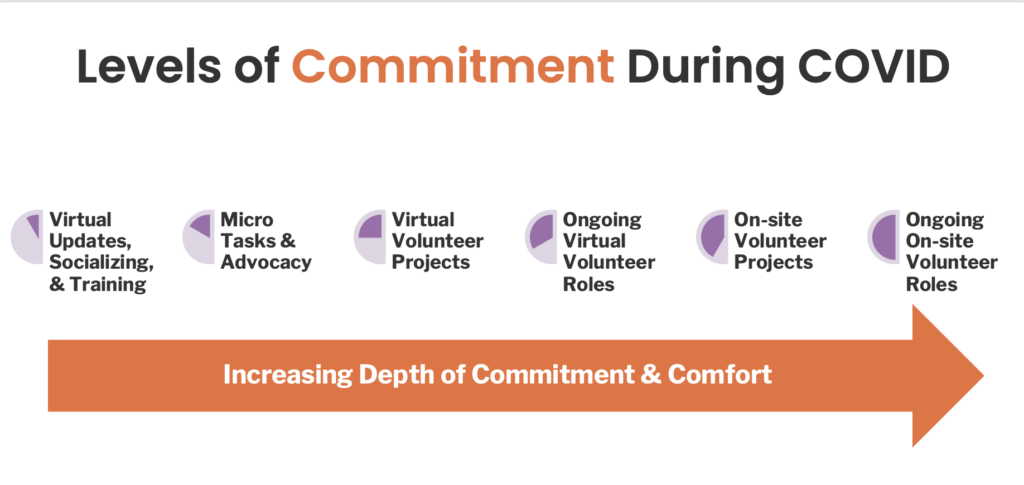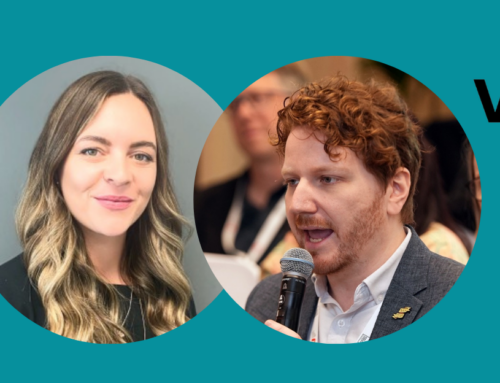Coordinating Volunteers in 2022: Five Smart Choices for Unlimited Growth
Coordinating volunteers in 2022 – what’s changed? Where should you focus your energy for the best results? What should you stop doing? What should you keep doing?
In this post, I share my top predictions and strategies that make the most sense for volunteer coordinators in today’s environment.
It’s the beginning of a new day, and there’s no time like the present to set your strategic course for the coming year.
While things still feel mighty messy and it’s difficult to know the future, that does not mean you can’t make decisions around your nonprofit’s approach to volunteer coordination.
The clearer and more decisive you can be, the more likely you will be to attract and retain dedicated supporters.
People like to follow leaders (and organizations) with a point of view and a plan.
They are not up for a wishy-washy experience – especially now.
The world as a whole is fatigued. But your organization still needs support.
So, your volunteer coordination strategy needs to be more nuanced than ever.
Below are a few suggested practices to get you focused for the year ahead.
5 Smart Decisions for Coordinating Volunteers in 2022
If you’re like most nonprofit staff, you are strapped for time and pulled in a myriad of directions.
Use these suggestions to help you decide upon a few key actions to drive greater volunteer engagement and results in 2022.
The operative word here is “choice.”
You don’t have to implement every single one. Choose a few that resonate most with you and that makes the most sense at your nonprofit.
You have more power than you realize to set a direction that is doable and sustainable.
Don’t make people guess about your direction or what’s expected.
In a chaotic world, clarity of purpose is one of the greatest gifts you can give your team in times of stress.
Below are some key decisions you can make to help bring that clarity to the forefront.
Decision #1: Choose to Think Differently & Manage Your Mindset
As nonprofit leaders, we are all faced with adversity regularly. It’s just part of the job of changing the world.
What makes this a problem for us is how we think about our challenges. The stories we tell ourselves generate emotions and these emotions generate decisions about the path ahead. And our decisions, create our results.
But it all starts with how we think about things – that becomes our self-fulfilling prophecy.
So, it’s vital that as volunteer coordinators and nonprofit leaders we practice good mental hygiene. Our thoughts don’t always stand for the truth. But they can be a predictor of the future if we allow them to go unexamined.
Think about the past year. What have you told yourself when challenges arose?
Choose something that bothered you, that you wish would have gone another way. Investigate your reactions or thought patterns related to those challenges.
Do any of these limiting thought patterns ring a bell?
- Volunteer management is the job of the volunteer coordinator only.
- Volunteers will never be interested in adopting our modern technology tools.
- We will never be able to build back our volunteer program to pre-pandemic levels.
- Volunteer services will never get the respect or resources it deserves.
- I am powerless to make progress around my volunteer strategy because of COVID.
- There is no way to make this work easier.
- Working myself to exhaustion, and without proper resources, is the only way to survive.
- I need to make everyone happy, or they will quit.
- It’s my job to say yes to every last-minute volunteer request from co-workers.
- I am a failure because I have not been able to steer my agency through COVID without disruption or mistakes.
As leaders, we are often very hard on ourselves. And this can have devastating consequences on whether we achieve our ultimate goals.
So, examine your throughs carefully – meditate, journal, take a walk. Do whatever it takes to find the silence needed to get in touch with those thoughts that are not entirely true.
Pinpoint them and decide which needs to be replaced with more healthy enabling beliefs.
For more on how to do more with less, check out our Top 5 Time-Saving Tips for Volunteer Managers HERE >>
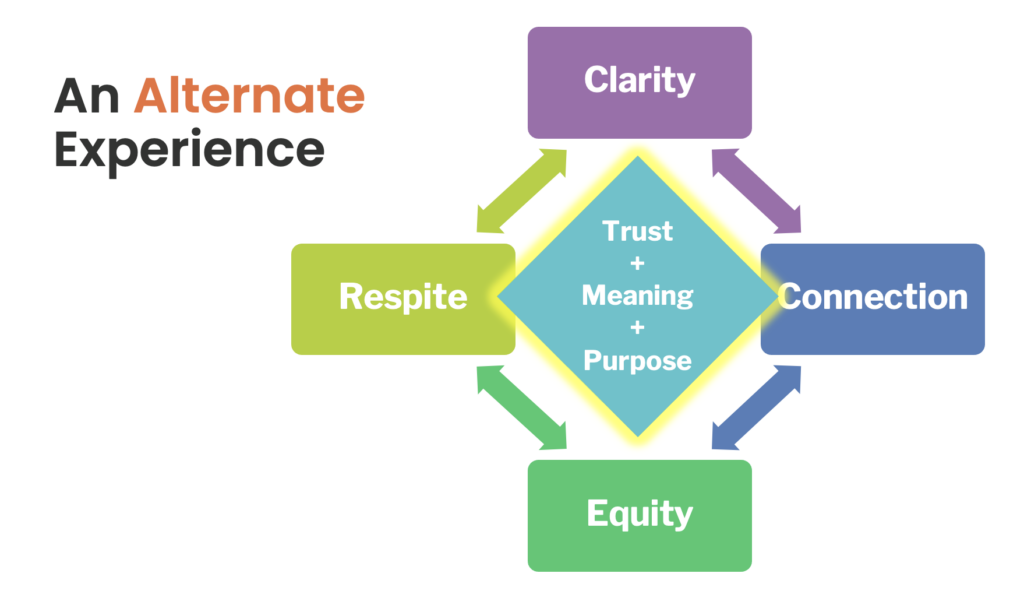
Decision #2: Choose to Design an Alternate Experience
The past two years have no doubt been emotionally challenging to everyone.
People have lost loved ones. Burnout and opting out are prevalent. So is fear and cynicism about the future.
But your organization can offer an alternative reality for supporters, if you choose to create it.
No, you can’t eliminate viruses from the world with a single sweep of your magic wand. (But wouldn’t it be cool if you could?)
Instead, think about what you do have the power to change.
The current environment brings up a lot of anxiety for people. So, what’s the alternative to anxiety and chaos?
Creating an environment that offers refuge, a place with a sense of fair play, a place to reconnect with people who care deeply about the common good, and place where volunteers can gain some sense of control over their destiny.
What if you could design a volunteer experience that offered a better reality than not volunteering? How could volunteering help people heal?
Consider how you could better meet volunteers’ informational AND emotional needs at every step of their lifecycle. Take a look at these critical inflection points in their journey:
- Volunteer application forms
- The volunteer screening process
- Attending the new volunteer orientation training
- Signing up for their first shift
- Attending their first shift or event
- Setting a regular volunteering schedule
- Asking questions and getting support
- Participating in ongoing in-service training
- Attending a social event for volunteers
Review the volunteer journey at your organization. Where are the points where volunteers get stuck?
Like all things that truly matter, improving the volunteer experience often entails added work. So, also choose how you will involve volunteers (e.g., as a welcome committee, Facebook group moderators, greeters, party planners, etc.).
Engaging volunteers is everyone’s job. So, make a purposeful decision that you will not go alone when it comes to making improvements.
Decision #3: Choose to Make Volunteering with Your Nonprofit Easier, Not Harder
The current pandemic has also added additional stress to organizations and has resulted in increased volunteer turnover or the inability to engage volunteers at the pre-pandemic level.
In addition, potential volunteers are juggling their life priorities and restructuring in some cases.
In today’s world, leaders who excel are relentlessly asking – how can I make things easier for my team in this environment?
Many nonprofits are finding success by pivoting to offer added flexibility to their available volunteer opportunities.
They developed a continuum of roles and levels of commitment or tailored roles that match a variety of volunteers’ safety and task preferences.
Organizations have added more flexible options to complement their traditional, long-term volunteer assignments, so volunteers have more choice.
Episodic or one-off volunteer roles are being added. Virtual volunteer opportunities are now part of the mix. Short-term team-based volunteering is now a possibility.
While offering a variety of flexible roles is not a new concept, it is a solid strategy to better adjust to our “new” normal.
So, decide what things you can adjust about your volunteer opportunities that meet BOTH your goals AND those of your supporters.
For more on Building Better COVID-Related Volunteer Roles, check out our guide and Volunteer Resourcing Plan Template HERE >>
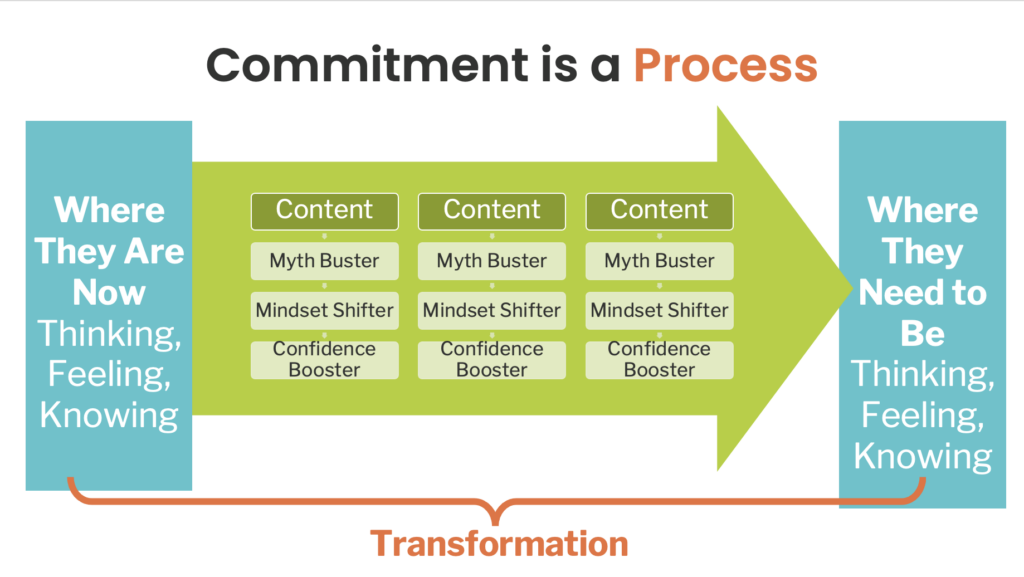
Decision #4: Choose to Embrace Content to Cultivate & Recruit Volunteer Talent
Unfortunately, there is no “buy button” in the brain.
When it comes to volunteerism, there is no secret phrase or special flier you can design that generates instant interest (and more importantly, action) in most people.
The reality is that commitment is a process, not a destination.
People take time to arrive at decisions, especially those that will change how they spend their time.
And many things are getting in the way of actually making a final decision to act. It’s easier to simply put it on the back burner for another day.
The good news is that you can help potential volunteers overcome their barriers to action and objections to service by using purposeful communications content.
Content in the form of social media posts, newsletter articles, free downloads, YouTube videos, blog posts, mini-trainings, and webinars, and your website can also be strategic ways to strengthen your relationships with future volunteers and get them to “yes!”
This content is not
Instead of a series of one-off asks, think about your volunteer recruitment as a process of building commitment through a journey.
Yes, it takes time. But volunteers who are more educated, feel a closer connection to you, and understand what’s really at stake will be more inclined to stick around for the long haul because they have a better understanding of what you do and how you do it.
Without understanding and directly addressing any doubts or confusion, volunteers are not likely to act.
So, with your content, your goal is to directly address the worries, limitations, beliefs, and mindset blocks that aren’t serving your ideal volunteer and keep them from taking action.
Taken time to better understand what thoughts might be “speed bumps” in their journey to commitment.
Then, decide to create content regularly throughout the coming year.
To make your life easier, create an editorial calendar for when and through which channel your content will be posted.
Here are three types of content we recommend to attract and cultivate the interest of new volunteers:
- Myth Buster
- Misunderstandings about your cause (e.g., 5 Myths About Homelessness)
- Misperceptions about volunteering (e.g., How You Can Make a Difference in Less Than 4 Hours a Month)
- Misinformation that impacts what you do (e.g., 7 Reasons Why Domestic Violence is Not a Private Issue)
- Mindset Shifter
- Calling out limiting beliefs (e.g., The Immense Power of Teens on a Mission)
- Widening or narrowing the lens (e.g., How Volunteering Helps Volunteers, Too)
- Future pacing (e.g., What If No One Went Hungry?)
- Confidence Booster
- Instilling new beliefs about capabilities (e.g., You Don’t Have to Be a Social Worker to Help Families Who Are Grieving)
- Reassurances about available support (e.g., The 10 Ways We Support Our Volunteer Superheroes)
- Hero’s journey stories (e.g., How One Soccer Novice Coacher Her Team to League Victory!)
You’ll not that all of these content topics speak of hope and a better future, while also removing any doubts from the reader’s mind that they have what it takes to contribute.
We believe that lack of self-confidence, rather than lack of time, is the primary reason people don’t volunteer. They simply don’t believe they have enough of the right stuff, or they doubt that their work will make a difference.
The right content, posted regularly, can help address any uncertainty and help unblock any indecisions that are holding people back.
Also, if your stories are inspiring, they can offer a new, more positive view of the world and educate your audience to become a better advocate for your cause.
Even if your followers decide not to join you as a volunteer, they will be more likely to make a financial contribution when the opportunity arises. Better yet, they will become ready to do both – donate and volunteer!
Decision #5: Choose to Elevate Your Vision for Volunteer Services
Each year, we hear from volunteer coordinators about the lack of buy-in and support for volunteers and volunteer services.
In the end, it is the Achilles heel that many nonprofits don’t realize they even have.
When it comes to meeting your mission, who is it that carries out all the work to make your mission? it is your people!
This includes both paid employees and unpaid volunteers if deployed effectively.
The quality and productivity of your team have a direct effect on whether you can get things done, on time, and with quality.
The X-factor is your people – all of them – so why not invest in supporting and equipping them for success?
When we “make do” with barebones support for volunteers, we get lackluster results.
Often organizations will blame the outcome on volunteers.
But it is the organization’s responsibility, not the volunteers, to design an experience where everyone can be successful.
So, why not call it for what it is?
Volunteer mobilization is a human resources strategy that your organization has chosen, in part, to adopt to meet its mission.
So, why treat it like a day labor program, or worse?
It’s time to elevate your view of volunteerism and level up our skills and strategy around it.
If your organization relies on volunteers, then it’s time to treat them as the valued asset they are.
Contributing time is much harder than contributing money, but you need both to have a sustainable nonprofit in today’s world.
Sometimes it takes a slight change in how we speak to bring about a change in thinking.
So, let’s choose to change our language, too.
Here are a few suggestions …
- From “volunteer recruitment” to “volunteer engagement”
- From “volunteers” to “volunteer talent”
- From “using volunteers” to “partnering with the community”
- From “screening” to “matching”
What other adjustments in vocabulary might speak to a new vision for volunteers at your organization? What resonates most for you?
Still dubious that your attitude about volunteers can change how others see them?
Try it for a month.
Elevate how you speak about the power of volunteers. Increase your expectations about how volunteers are spoken of and treated. Set boundaries for what you are willing to do (in other words, stay in your lane and don’t rescue others).
While we can’t change how people think, feel, and act, we can influence them through our actions.
Leading by example is a powerful way to do so.
For more on the links between volunteers and donors, check out Utilizing Fundraising Volunteers During Coronavirus HERE >>
So, there you have it!
The top five things we recommend you embrace in the year ahead.
Many require a new way of thinking about volunteer coordination.
The world is evolving, and volunteer organizations must evolve to not only survive but thrive.
It’s going to be a wonderful year of growth ahead!
Are You Ready to Make the Most of Volunteer Coordination in 2022?
If you are ready to build, grow, and scale your volunteer efforts in 2022, then our signature online course is the perfect fit for you.
We will be opening enrollment in early 2022. So, now is the time to join our waitlist so that you get our early alerts when the doors are about to open.
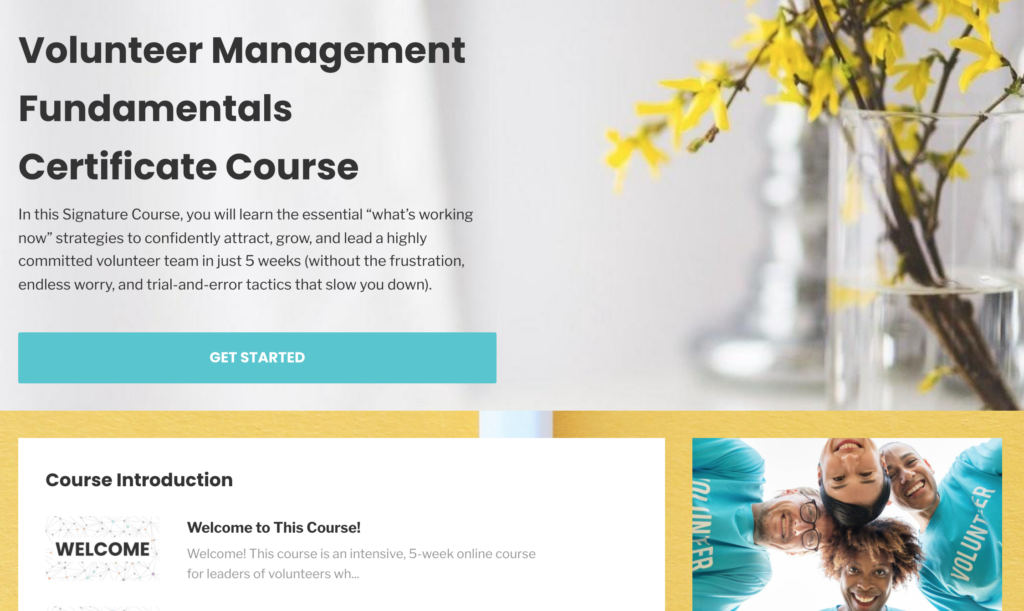
Opening in Early 2022: Volunteer Management Fundamentals Certificate
Join us for the most comprehensive program in the field for leading a high-impact volunteer engagement strategy that works.
This online course is the only implementation program of its kind that not only shows you exactly how to attract qualified volunteers – but how to make your org the place they want to return to again and again.
Over 8 weeks of instruction, you will learn everything you need to implement or make improvements to your volunteer programming. As a student, you’ll also be invited to our live Q&A coaching calls and have lifetime access to the course.
LEARN MORE & JOIN THE WAIT LIST >>



